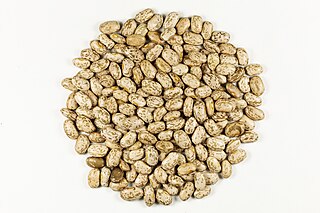Black beans and pinto beans differ most noticeably in shape, size, and color, but these legumes also differ significantly in nutritional content and in how they are cooked and eaten. When dry, a pinto bean is brown with white flecks; it turns pink when cooked. Black beans are always black with a creamy white center and contain fewer carbohydrates than pinto beans.
Comparison chart
Nutrition
Pinto and black beans stack up when it comes to nutrition per serving. Both offer a lot of protein and fiber in a package with a similar number of calories.
However, pinto beans contain a slightly more carbs and a higher fat content than black beans, attributed mainly to their high starch content.
Compared to other foods, black and pinto beans are virtually fat free.
Purines
Both beans contain a naturally occurring chemical called purines. Some research has shown that purines cause an excess of uric acid in humans, which can lead to gout and the formation of kidney stones.
In Cooking
When dry, pinto and black beans require at least one hour of boiling for approximately three cups. Soaking the beans for 6 to 8 hours lessens the overall cooking time.
Canned beans are precooked and often only require reheating before serving.
Cuisines
Cooked black or pinto beans add flavor and bulk to virtually any dish, from salads and soup to rice. However, each bean is tied to a signature ethnic dish:
In America, pinto beans are used most often in Mexican-style cuisine. You might recognize these beans in their mashed form as refried beans, used in dips and to fill burritos and other wraps. Pintos are also a staple in Brazil, along with meat and rice.
The black bean is served as staple in almost all of Latin America, and many Hispanic enclaves in the United States. It is a very popular bean in several regions of Brazil, and is used in feijoada, the national dish. It is also a main ingredient of Moros y Cristianos in Cuba, a must-have in the typical gallo pinto of Costa Rica and Nicaragua, and base of pabellón criollo in Venezuela,In the Dominican Republic cuisine, it is also used for a variation of the Moros y Cristianos simply called Moro de Habichuelas Negras. The black turtle bean is also popular as a soup ingredient. In Cuba, black bean soup is a traditional dish, usually served with white rice.
Black beans are also extremely popular in Southwestern and Caribbean dishes.
Texture
One important distinction between the two beans – especially for those who want to experiment with cooking – is the texture.
Black beans are slightly smaller, and have a firm, al dente texture. This firmer texture is why black beans are used in soups, because they can stand up to high temperatures and resist moisture that might turn other beans mushy. Black beans are often described as having a mushroom texture.
Conversely, pinto beans are excellent for mashing, and do have a similar texture to that of a boiled potato.
Origin
Plant
Both pinto and black beans come from leguminous plants, which are essentially plants that offer beans as fruit. Similar plants produce edibles like tamarind, peanuts, and lentils. The beans essentially define the plant they come from, so you could use dried or fresh beans as seeds if you intend to grow beans in your garden.
Geographic Origin
The black bean originated in Central and South America, and was used extensively by indigenous populations there. The bean was transported to Europe during the 15th century by Spanish explorers. From there, it spread to Asia, where it is used today.
The pinto bean also originated in Peru, and was eaten as long ago as 300 BCE in Brazil. Migrating indigenous tribes took the pinto as far north as Colorado. It remains a staple and the most popular bean in Mexico and North America.
Etymology
The black bean, or turtle bean, is named for its signature color, which does not change when cooked. In Spanish, “pinto” means painted, referring to the bean's brown-with-spots appearance. However, the pinto only appears this way when dry and uncooked.





 Cilantro
Cilantro  Shallots
Shallots  Rutabaga
Rutabaga  Squash
Squash  Sweet Potato
Sweet Potato  Olive Oil
Olive Oil
Comments: Black Beans vs Pinto Beans